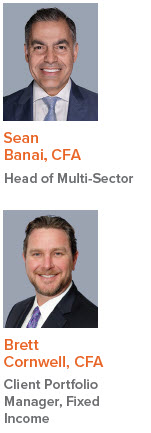
On September 12, Voya’s experts and special guests discussed five topics at the forefront of private credit investors’ minds—from integrating private credit into pension portfolios to exploring new frontiers. Here’s a summary.
Session 1: Retirement reimagined—IBM’s approach

An overview of IBM’s pioneering work in integrating investment grade private placements into its defined benefit and defined contribution investment plans, as well as recent strategic moves to ensure all employees are financially secure and retirement ready.
IBM has been incorporating investment grade private credit (PCIG) into its pension trust for almost a decade, making it a pioneer among pension funds—and a champion of Voya’s innovation in developing a multi-sector solution that blends public and private investment grade fixed income. Dineen explained the rationale behind the trust’s embrace of PCIG as issuer diversification, structural protections, and the pursuit of additional spread pick-up. The panelists discussed how they structured these allocations, whether through co-mingled funds or separate accounts, and how they blended public and private assets to achieve desired outcomes.
The implementation process of the trust’s move into PCIG involved a gradual build-up of allocations starting with private placements. Challenges such as benchmarking and internal communication strategies were addressed—although while talking about the supposed difficulty of liquidity management, Dineen noted, “the public market, ostensibly more liquid, can be actually less liquid than the private credit market in certain areas.”
The discussion concluded with a look at the inclusion of private markets in 401k plans, exploring the use of private fixed income in defined contribution plans and the experiences with private investments in stable value setups, particularly highlighting the successful integration with insurance wraps due to their familiarity with the asset class.
Session 2: Public and Private Integration in Portfolios

Implementation challenges and opportunities for a multi-sector public/private approach, including vehicles and benchmarking.
Brett Cornwell and Sean Banai provided a comprehensive overview of how plan sponsors have approached the inclusion of PCIG and commercial mortgage loans (CML) along with public IG credit in a liability-driven portfolio. A key theme was the benefits of a multi-sector approach rather than standalone allocations.
They built off Mike Dineen’s positive experiences with IG private placement liquidity to emphasize that PCIG is, contrary to what is generally assumed, liquid. This fed into a discussion of the primary advantage of multi-sector strategies, which is that it allows for dynamic adjustments between public and private investment grade credit to optimize performance against public benchmarks, conferring better absolute and risk-adjusted returns to their clients.
Cornwell and Banai also focused on the importance of strategic benchmarking in multi-sector strategies. Benchmarks need to be carefully selected to align with specific investment goals as well as being liability aware. Existing clients utilize a variety of intermediate and long duration benchmarks. This approach highlighted Voya’s flexibility and skill in developing successful multi-sector strategies, challenging traditional views on market liquidity and showcasing their potential to enhance portfolio performance in today’s pension investment landscape.
Session 3: Covenant Chronicles—Reshaping the Deal

A market review of current trends in private placements and commercial mortgage loans, including origination, covenants, issuance, duration, and— yes—liquidity.
The disintermediation of banks has notably increased opportunities for leaders in the PCIG space such as Voya. Panelists unpacked how this shift has allowed nonbank entities to fill the gaps, particularly in terms of lending and financing. They discussed significant trends in new issuance, particularly how the types of covenantlite deals traditionally seen in the broadly syndicated loan market are starting to appear in the IG private placement market. This trend, coupled with the recent rally in rates and market volatility, has influenced borrower behavior and deal structures, with demand continuing to far outstrip supply. The panel touched on the improving liquidity in the secondary market before closing out the PCIG discussion with outlook for the rest of the year, considering it’s an election year and the start of a Federal Reserve cutting cycle.
The focus of the conversation then shifted to commercial mortgage loans, where the withdrawal of banks from the market has also created a changed landscape in real estate debt markets. Panelists shared current structures in new issuances and how they are adapting strategies to work with borrowers within the landscape of lower bank involvement. Office was highlighted, with discussions on whether the market is beginning to see a bottom as family offices and institutions start engaging more actively. In turn, however, multi-family is showing signs of stress in specific areas, driven by various factors including higher interest rates and rising expenses such as insurance. Additionally, the recent rate rally has been a catalyst for increased issuances, including refinancings and acquisitions, which has served to make more deals viable.
Session 4: External Perspectives—The Rise of Secondary Trading

The advent of club/agent market sourcing opportunities has led to the growth of secondary trading, which further facilitates liquidity.
As most people outside of the PCIG market are very curious about the available liquidity in the marketplace, it was great to have an in-depth discussion about those market dynamics with Chris Lyons, Matthew Faranda, and Frederick Echeverria. Each one of these individuals brought deep experience and great familiarity with the market. Chris led the Voya IM Private Credit (or private placement) group for nearly two decades before his promotion to head of private fixed income and alts at Voya. Matthew Faranda started his career working at Barclays as a secondary trader for private placements and later moved to Stonecastle Securities, which is now the largest secondary trader in the PCIG marketplace. Frederick Echeverria is a leading sell-side agent in the infrastructure portion of the market with decades of experience bringing complex private placement transactions to investors.
Unlike other private marketplaces, the PCIG market has unusual dynamics where there is good liquidity to sell bonds allocated to investors in the market, but more limited liquidity to buy specific desired bonds on the secondary market as most investors are buy-and-hold in their strategy. In other words: demand outstrips supply.
“Liquidity for a security is really about the ability to convert it into cash when needed,” said Chris Lyons. A critical point, as most institutional investors in the PCIG market are more interested in having the flexibility to sell quickly when necessary, and less concerned about the ability to actively trade their portfolio or rotate it into different sectors as they might in the public investment grade market.
Matthew added that the size of the PCIG secondary market is approximately $3 billion per year, with Stonecastle responsible for about half to two-thirds of that volume. Most trading tends to be driven by: 1) mergers and acquisitions that then create portfolio transfer opportunities, and 2) accounting and tax trades that are focused on minimizing losses in PCIG by selling shorter duration paper.
Demand for investment grade secondary securities is strong from existing investors given that they follow credits and rarely get the full allocation that they desire. Demand for distressed credits is also strong, but typically comes from distressed funds who are looking for opportunities for value.
The discussion pivoted to market participant proclivities. Frederick shared how typical infrastructure deals have a group of sophisticated investors who will be following that credit on an ongoing basis. He also confirmed that most investors are unable to achieve the entire allocation they seek out of individual deals, which creates ongoing demand to increase position holdings when secondary opportunities do arise.
Session 5: New Relative Value Opportunities

Where to go after PCIG: BB/BBB rising stars, construction lending, fallen angels, and infrastructure.
Chris Lyons opened by discussing his leadership in developing a private placement platform which manages a significant amount of third-party external capital as well as underwriting complex transactions in the ABS and Infrastructure subsectors. The private placement market continues to evolve, especially with entrants from private equity creating new opportunities. Chris emphasized the importance of leveraging the team’s extensive network and expertise to identify and capitalize on these opportunities, ensuring optimal value for clients. He also mentioned Voya’s strategic position as a favored partner among major players like Apollo and Brookfield, which grants unique access to exclusive deal flows for all clients on Voya’s platform.
Greg Michaud shared insights from his role leading the $15 billion real estate finance team, focusing on the opportunities and strategies in core and bridge commercial mortgage loans. He discussed how the team’s comprehensive in-house capabilities in production, asset management, credit and servicing allow for a nuanced assessment of potential deals and a maximization of client value. Michaud also expanded on the impact of recent bank pullbacks discussed in a prior panel, noting that a decline in available regional bank capital has created liquidity voids and thus new opportunities for private lenders to step in and secure premium returns—with construction lending being a prime example.
Additionally, he touched on the regulatory changes affecting the commercial mortgage lending sector, particularly the new, stricter GSE regulations on multifamily properties. These changes are a net benefit to lenders like Voya as they increase the appeal to borrowers of non-agency commercial mortgage loans.
A note about risk
Principal risks are generally those attributable to bond investing. All investments in bonds are subject to market risks as well as issuer, credit, prepayment, extension and other risks. The value of an investment is not guaranteed and will fluctuate. Market risk is the risk that securities may decline in value due to factors affecting the securities markets or particular industries. Bonds have fixed principal and return if held to maturity but may fluctuate in the interim. Generally, when interest rates rise, bond prices fall. Bonds with longer maturities tend to be more sensitive to changes in interest rates. Issuer risk is the risk that the value of a security may decline for reasons specific to the issuer, such as changes in its financial condition. Liability valuations can increase due to falling interest rates or credit spreads, among other things, as the present value of future obligations increases with falling rates and falling spreads. Liabilities can also increase due to actual demographic experience differing from expected future experience assumed by the plan’s actuary. Diversification or broad asset allocation, in and of itself, neither assures nor guarantees better absolute performance or relative performance versus the pension plan’s liabilities. In addition, investing in alternative investment products such as derivatives can increase the risk and volatility in an investment portfolio. Since investing involves risk to principal, positive results and the achievement of an investor’s goals are not guaranteed.
